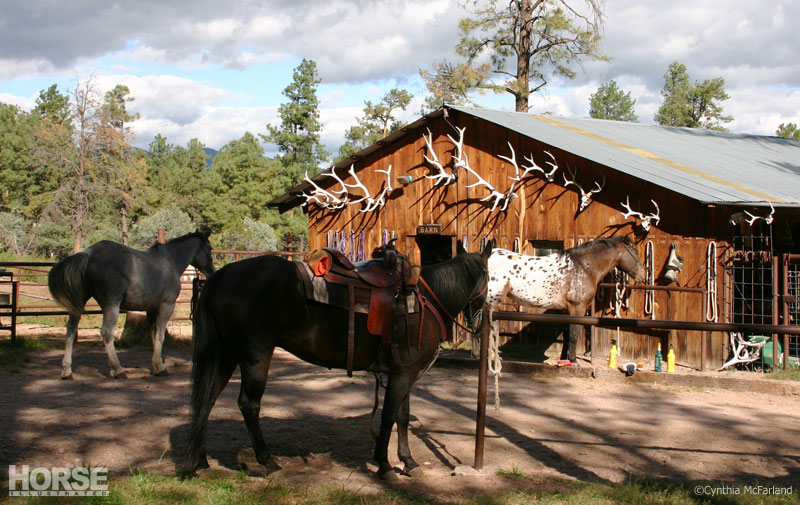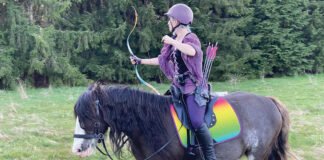There was a time when virtually every domestic horse was a “working” horse. That’s not to say people didn’t love or appreciate them, but horses had jobs and that was their main purpose.

Working horses at the Geronimo Trail Guest Ranch in New Mexico. Photo: Cynthia McFarland
Although every conscientious horse owner is concerned about her animals’ well-being, overall health is especially important when horses work for a living. To find out what owners/managers do to keep working horses healthy, we spoke with a guest ranch and lesson facility, businesses that are completely dependent on the health and soundness of their horses.
Caring for Guest Ranch Trail Horses
At Geronimo Trail Guest Ranch (www.geronimoranch.com) in Winston, New Mexico, horses are an essential part of the business since trail riding is the main focus. The ranch, which is owned by Harry, Diana and Meris Esterly, averages two dozen horses in the riding string. Since the guest total is limited to 16 and averages 8 to 10, this allows horses to have regular time off.
“On average, our horses work 15 to 30 hours a week, depending on the length of the guests’ stay and amount they want to ride. These are actual riding hours, not including breaks during lunch, etc.,” says Meris, who manages the family-owned ranch and is head wrangler. “We try to match one horse for each rider and stay with that match (unless it is not a good one), so horse and rider can bond and get to know each other over the course of the week. The horses that work one week will then typically get the next week off, as we have enough horses to do a full rotation from week to week most of the time.”
Hoof Care:
Because of the rugged environment, good hooves are important.
“You know the saying, ‘No hoof, no horse.’ We pick the horses’ feet before and after every ride. We certainly try to buy horses with good feet because of our terrain,” Meris notes. “On a rare occasion we will take a chance on a horse whose feet aren’t in the best condition—usually from neglect, not genes—if the horse seems like a very good bet otherwise. We have had good luck getting their feet in better shape since we have a very good farrier.
“With very few exceptions, our horses have to be shod all around for riding in our rocky terrain,” she adds, noting that horses are shod every six to eight weeks, or more often when necessary. “The shoes are usually worn out after six to eight weeks and the horse will need a new pair. We use Kerkhaert SX8 (the thicker ones) and this is still the case. We do pull their shoes after our season ends in late November/early December and they get shoes put back on in mid to late February. This is very good for their feet.”
Nutrition:
The ranch feeds high quality forage to keep its horses in prime condition.
“We’ve found that feeding half grass hay and half alfalfa works best for us,” says Meris. “We typically do not grain our horses as that just gives them too much ‘rocket fuel.’ Only when we have one that needs to put on a little more weight will we give them some Nutrena Empower™ Boost High-Fat Rice Bran Supplement or a senior feed. In the horse pastures, we always keep salt trace mineral blocks to encourage them to drink plenty of water, as well as Purina® Free Balance 12:12 Blocks (a balance of vitamins and minerals designed to replace any deficiencies in the diet).”
Vaccinations:
All horses are vaccinated annually for Eastern and Western Encephalomyelitis, West Nile, tetanus and rabies. Since horses don’t typically leave the area or come in contact with other horses, it’s not necessary to vaccinate for diseases such as influenza and rhinopneumonitis.
Because of the remote location, the ranch staff handles vaccinations and general health care, but a veterinarian with a mobile practice comes at least once a year, usually in the spring, and every horse gets an annual check-up at that time.
Parasite Control:
“We deworm four times a year using Safeguard in the spring, Quest in the summer, Equimax in the fall and Strongid in the winter,” says Meris. “Our vet helped us decide on this rotation and schedule based on our area and climate.”
Dental Care:
Horses have their teeth floated every other year, or more or less frequently, depending on the horse.
Caring for School Horses
Hidden Lark Farm (www.hiddenlarkfarm.net) in Ocala, Florida, is a full-service hunter, jumper and equitation barn offering boarding, lessons, sales and training. Of the 20 or so total horses on the farm, six are used for lessons; the rest are privately-owned boarded horses.
“Our school horses range in age from 11 to 17, so they’re all middle-aged. They have a great life and usually only work three to four hours a week,” says farm owner and head trainer Lisa R. Kraut, who formerly served as head coach of Central Florida College IHSA hunt seat team. “They’re almost never used for more than one lesson per day. We try to keep it that way since most of them are teenagers and we want them to have longevity.”
Hoof Care:
Lesson horses are either barefoot or shod in front only and the farrier trims/shoes them every six weeks. Because the soil is sandy and there are no rocks to speak of, horses with excellent feet and those just used for flat work go barefoot. Horses used for jumping and those with lesser quality feet have front shoes. Students apply hoof dressing to the horses’ hooves regularly as part of the grooming routine.
Nutrition:
Because the school horses include everything from a 12.2 hand pony to a 16.2 hand horse, the feed program is designed to meet each individual’s varying requirements.
“We feed a 12% protein pellet and soaked beet pulp, and a mixture of alfalfa and coastal grass hay, but it’s all portioned differently for each horse, and tailored to fit their metabolism, body type, work load and temperament,” says Lisa, adding that lesson horses are turned out on pasture 24/7, except when being handled and ridden by students.
“A couple horses that have lesser quality hooves are on Farrier’s Formula® Hoof Supplement,” says Lisa. “We also add regular table salt to every horse’s feed to encourage water consumption. That’s important because of sand colic concerns here in Florida; my vet recommends this to keep everybody drinking well.”
Parasite Control:
Lesson horses are dewormed every other month using a rotation of products through the year. Because of the climate and exposure to different horses, they are vaccinated in the spring and fall for Eastern and Western Encephalomyelitis, West Nile, tetanus, influenza and rhinopneumonitis.
Dental Care:
Horses’ teeth are floated every other year or more often, if needed.






Great article.
Trying to find the quiz.